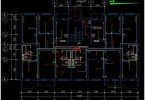What is a power surge and all about protection from it
Whether we live in a city or in a village is not important. In any case, we all use electricity. This lighting, and various household appliances, designed to make our life more comfortable. However, in our network, voltage is not always equal, able to maintain stable operation of electrical equipment. On the contrary, when voltage goes beyond the known norms, equipment breakdowns, especially electronic ones, are quite possible. That is why protection against power surges is becoming increasingly necessary, especially since most modern devices are notable for their considerable price and value..
Content
- Mains voltage fluctuations
- Surge Protection Methods
- Voltage monitoring relay
- Uninterruptible power supplies
- Surge Protectors
Mains voltage fluctuations
So why are we constantly at risk of losing our own property? The reason in most cases is the same – at the moment, the nationwide energy supply system is not doing its job. Each of us knows that the network must have a voltage of 220 V. But in fact, the voltage varies depending on the load on the network, sometimes even in a fairly wide range. This is most noticeable in rural areas, where the power supply system is much weaker than in the city.
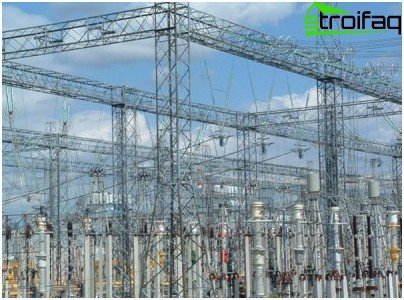
Electric power distribution system
What is this happening for? And you try to remember when power plants and other elements of electricity supply were built. Remembered? Well, at least approximately? Now think about what exactly (for individuals) electrical engineers were counting on, creating this entire system. Lighting, a refrigerator, an iron, a TV, possibly a heater and a simple washing machine – and this is the maximum!
What do we have now? Literally over the past 20-30 years, the number of household appliances has grown incredibly, on the one hand, significantly improving our lives, and on the other, specifically increasing energy consumption. So the old system does not cope with the new requirements. And this is unlikely to change in the near future. You yourself understand very well that the state will not invest in global reconstruction. Therefore, we have to make sure that everything is in order in the house.
And now let’s talk in more detail about voltage drops. Most often, the voltage in the network changes quite smoothly, and almost all of our devices and equipment cope with such loads, while remaining in working condition. Indeed, even the most “delicate” devices are designed for voltage drops in the range of 198-242 V. But there are also times when the voltage rises to extreme values with a sharp pulse, and then also suddenly drops. Such a situation is called a voltage surge in the network. Are there any specific reasons for such leaps? We list the most basic:
- simultaneous switching on or off a large amount of electrical equipment (most often this happens where industrial enterprises are located nearby, consuming really large capacities)
- a break in the zero wire (in this case, the very reason that we already discussed is triggered – old equipment, and even with poor maintenance, it just can’t cope with the load and the zero-phase wire burns out, causing a short circuit)
- an error when connecting wires on a common electrical panel (mainly because of the incompetence of those who are involved in this, it can be either a drunk electrician or a too self-confident landlord)
- lightning discharges occurring on the power line, as well as breaks on these lines (for example, due to the fall of trees on them)

Old equipment in a bad maintenance box
And whatever the cause of the power surge, we simply cannot predict it. Therefore, it is worth taking care of protection from this scourge in advance.
Surge Protection Methods
Of course, the best way of protection would be to reconstruct the energy distribution system in at least one separate building and bring a competent electrician to its service, but – and this is clear to any person living in an apartment building – this option is practically impossible. Won’t you pay all this alone? And replacing electrical wiring only in your apartment does not guarantee protection against power surges. They themselves saw that the reasons for the jumps relate specifically to general equipment, which, in theory, should be responsible for state structures, for example, housing office.
And what remains for us? In principle, there are several devices of various types of actions that may well help in conditions of unstable tension. In order to reduce or even eliminate the likelihood of damage to our equipment due to power surges, the following devices are now used:
- voltage monitoring relay
- uninterruptable power source
- Voltage regulator
It remains to choose the protection that is best suited exactly in your case.
Voltage monitoring relay
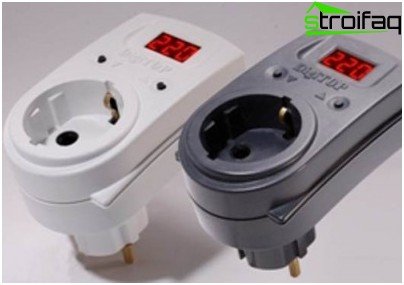
Power surge protection unit – voltage control relay connected to the shield
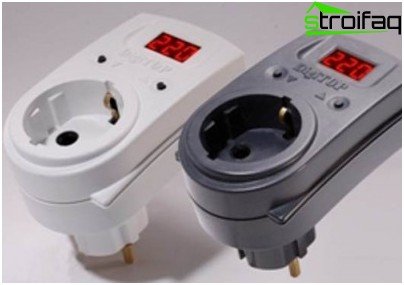
Surge Protection Devices – Individual Type 2 Voltage Monitoring Relay
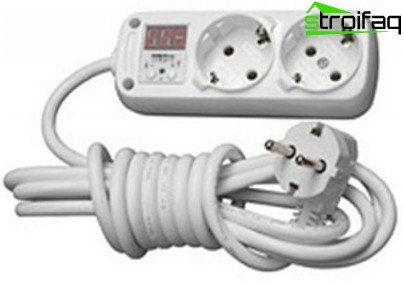
Surge protection devices – individual voltage monitoring relay for several sockets
If voltage surges in your house are rare (that is, they occur in truly force majeure circumstances, such as a lightning discharge), a voltage control relay may well suit you. It’s worth mentioning right away: such a relay only reads voltage data, but does not affect its stability. What is it? Voltage relay – a small device that turns off the equipment during a power surge and turns on after the voltage returns to normal. There are various types of this device, which can be divided into two types:
- general power surge protection unit, mounted in a shield (control cabinet) and protects your entire apartment or house
- a device for individual devices, similar to an extension cord having socket outlets for one or more connections
When buying a voltage relay, you should correctly calculate its power – it should be slightly more than the power of all energy consumers connected to the relay. Therefore, individual relays connected to the network are much more convenient to choose, since everything is already calculated according to the number of outlets.
Such relays are convenient and not very expensive, but, unfortunately, they will not protect against long-term voltage surges (a prolonged high or low voltage in the network). Well, unless you like it when your appliances or all of the electricity in the apartment is permanently turned off.
Uninterruptible power supplies
A UPS is an uninterruptible power supply (the name in English is UPS – Uninterruptible Power Supply) – as the name implies, they can give some reserve of working time for electrical or electronic devices during a power outage due to built-in rechargeable batteries. However, besides this, some species can still perform the function of a stabilizer, giving a normal voltage output.
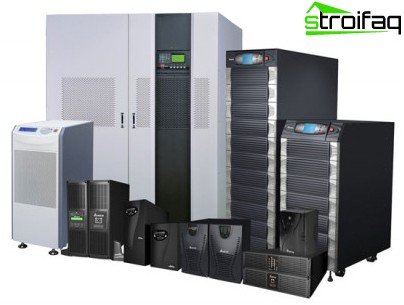
Surge Protection Devices – Uninterruptible Power Supplies of Various Types
So, all uninterruptible power supplies can be divided into three types:
- the backup circuit device (Off-Line-UPS) simply switches the power of the connected equipment to the battery (backup) when the power is turned off
- an interactive circuit device (Line-Interactive-UPS), in addition to switching to a backup power supply circuit, allows you to equalize small voltage drops thanks to the built-in stabilizer
- device with a double conversion mode (On-line-UPS) constantly adjusts the frequency and voltage supplied to the output
Each type of UPS has its drawbacks. For example, Off-Line-UPS spends on switching power from 4 to 12 ms, but noiseless and cheap. And On-line-UPS, because of its complexity, is noisy, heats up and is very expensive. But here is the master – master, what you liked, then choose.
When choosing, pay attention to the UPS power, battery capacity (battery life), battery life and the ability to replace them, the configuration of outlets, as well as the width of the line voltage range that the UPS can stabilize. Since the bulk of the UPS is purchased for the PC, all these characteristics are quite important and should be selected taking into account the technical characteristics of your computer.
Surge Protectors
One of the most reliable, but also the most expensive, types of surge protection device is a network stabilizer. These devices give the output a normal voltage, regardless of the voltage in the network. This is a great way out for situations where voltage changes are frequent or even constant..
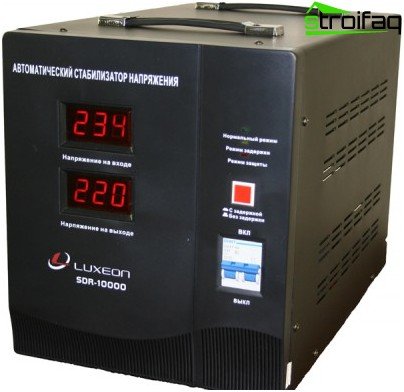
Surge Protection Devices – Automatic Voltage Regulator
It remains to figure out which stabilizers to choose in various cases. Most often, stabilizers are divided according to the principle of action:
- relay – the most inexpensive, not very powerful, but their technical characteristics are quite acceptable for household appliances
- servo-drives (electromechanical), surprisingly, but despite the higher price, these devices by some qualities do not even reach relay
- electronic (thyristor or triac), almost silent, with good speed and protection against power surges, normal power and accuracy, decent durability, and with an appropriate price
- electronic double conversion – this stabilizer has the most necessary technical characteristics (accuracy, speed and protection against power surges) at the moment the best, but also the maximum price
Also, stabilizers can be single-phase and three-phase (for home use – single-phase), connected to the entire home network or to a separate technical device, stationary and portable. Choosing a stabilizer for your own needs, you need to know the power of the devices that you are going to connect to the stabilizer, as well as the maximum voltage values in the network. In order not to get confused in all these data, it is best to use the help of specialists when choosing who will be able to choose the most optimal option both in terms of protective properties and price.
After analyzing all this information, it becomes quite clear that reliable protection of our property from power surges in the network can only be ensured by a super-powerful (and therefore super-expensive) voltage regulator. However, with a clear understanding of what is happening in the power supply network, you can choose more optimal options for the device or devices designed to save our expensive equipment from voltage problems. In this case, you should contact a specialist who will be able to determine the main problems in the network and already with this knowledge proceed to the selection of protective devices. As they said in antiquity: my house is my fortress, and the defense of borders continues now, albeit on a slightly different level.





